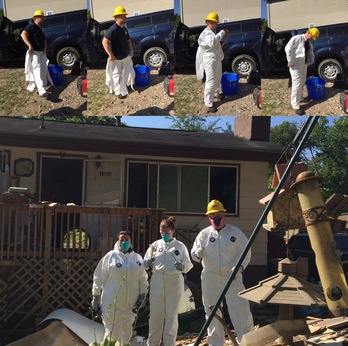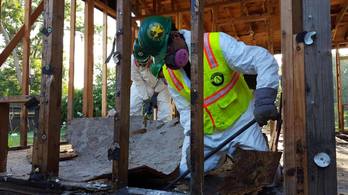 
Teams continue to work in West Virginia responding to the
devastating floods that occurred in June.
In Greenbrier, Nicholas, Kanawha, and Clay counties, teams have been
working with area residents and other organizations to provide disaster
relief. Through the efforts of Washington Conservation Corps, Great Appalachian
Valley Conservation Corps, SBP,
Hoopa
Tribal Civilian Community Corps and AmeriCorps
St. Louis ERT, these teams have accomplished:
- 43 damage assessments
- 27 structures mucked and gutted
- 22 homes sanitized for mold
- 336 cubic yards of debris cleared
- 101 tons of donations sorted
- 79.5 tons of food
collected/distributed
- 8 volunteer reception centers
supported
- 1,497 volunteers registered
- 7,341 volunteer hours leveraged
In addition, an Atlantic Region AmeriCorps NCCC team deployed on July 17 to aid in mucking/gutting operations in Clay and Kanawha Counties in partnership with Volunteer West Virginia and NECHAMA.


Flood response work continues in Texas under the leadership
of AmeriCorps Disaster Response Teams in Brazoria County. Currently, Texas Conservation
Corps, Southwest Conservation Corps and Hoopa
Tribal Civilian Community Corps are deployed to support the disaster
response.
- 40 structures mucked/gutted
- 1,425 cubic yards of debris cleared (that’s
equivalent to over 287,000 gallons)
A North Central Region AmeriCorps NCCC team deployed on July 16 to assist in mucking/gutting operations in Ft. Bend, in partnership with All Hands Volunteers.

The CNCS Disaster Cadre is a key component of the CNCS
Disaster Team. The Cadre is comprised of
CNCS employees, from across the agency, who provide on-the-ground coordination
of A-DRTs. Cadre work with the CNCS
Disaster Services Unit and our state and federal partners to ensure that our
programs can continue to provide the level of disaster response needed in
communities hit hard by storms.
Recently, in West Virginia, two Cadre team members deployed
to assist teams on the ground. Liz Jung, an AmeriCorps VISTA staff
member and Cali Cornacchia, the
current Eli Segal Fellow have been providing support to the deployed A-DRTs and
FEMA.
Liz Jung reflected, “Supporting the A-DRTs and building
relationships in the JFO (Joint Field Office), at the Commission or in the
community may sound nebulous but these efforts are critical to ensure that
A-DRTs on the ground are successful.”
“Working with the ADRTs to go through all aspects of the disaster
and begin to create a common set of expectations, processes, and curriculum was
my first project as and Eli Segal Fellow - so it is great to come full circle
to be able to see how everything discussed actually happens on the ground,”
said Cornacchia.
The CNCS Disaster Cadre continue to be a vital resource to
the National Service role in disaster response and recovery efforts.
|
|